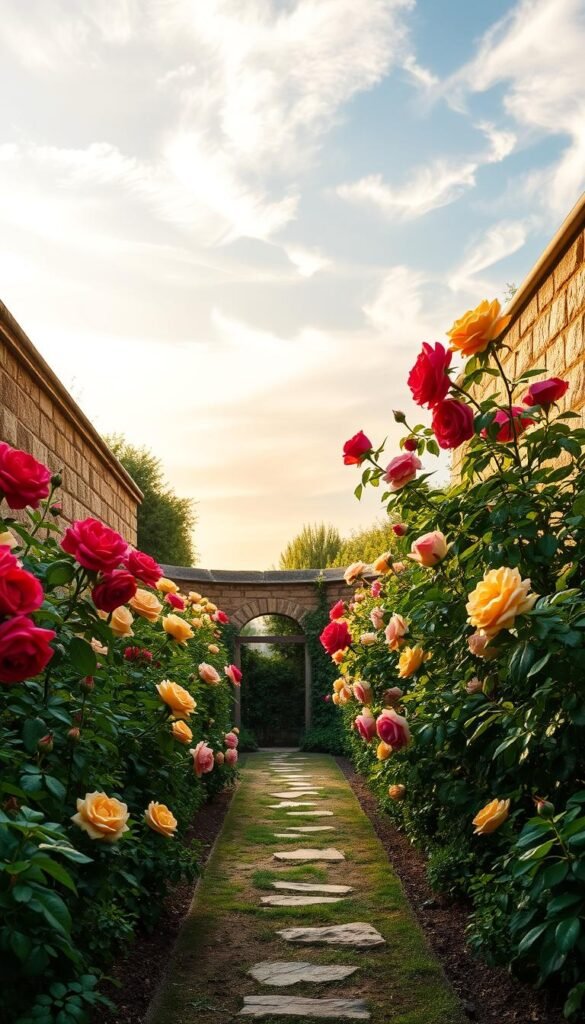Imagine stepping into a space where vibrant blooms and soft fragrances surround you. Crafting a timeless outdoor retreat starts with thoughtful planning, blending nature’s artistry with your personal vision. Whether you’re drawn to bold hues or subtle tones, the key lies in balancing form, function, and harmony.
Many enthusiasts focus solely on planting their favorite types, but true elegance emerges when varieties complement each other. Tall climbers add vertical drama, while compact bushes create structure. For inspiration, explore classic cottage-inspired layouts that mix textures and heights for year-round appeal.
Color coordination transforms random plantings into cohesive displays. Soft pinks paired with creamy whites evoke romance, while rich reds and purples deliver sophistication. Don’t overlook fragrance—sweet-smelling blooms attract pollinators like bees and butterflies, turning your yard into a lively sanctuary.
With careful selection, your outdoor area becomes more than a collection of plants—it’s a living masterpiece. Start by sketching ideas or studying established designs. The right choices ensure continuous beauty, season after season, making every glance through your window feel like a moment of pure magic.
Understanding the Essence of a Classic Rose Garden
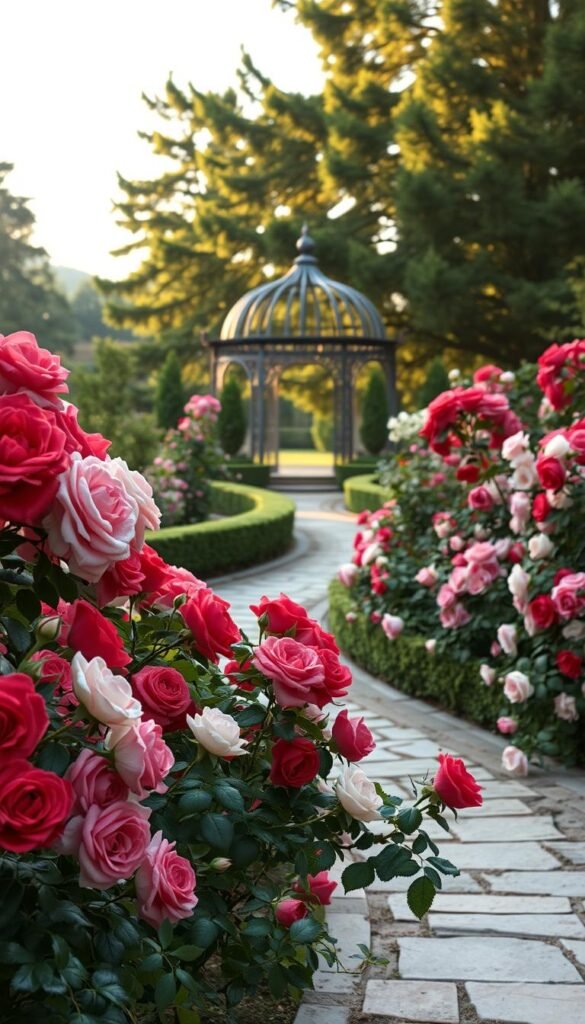
Picture sunlight filtering through arching stems, their petals glowing like stained glass. This is the magic of a space shaped by generations of design wisdom, where every element whispers stories of romance and refinement.
Defining the Timeless Aesthetic
True elegance thrives in balance. Think of climbing varieties framing a weathered bench, their blooms cascading beside neatly trimmed shrubs. Soft pinks and whites blend with lavender accents, while fragrant petals perfume the air. It’s not just about flowers—rustic stone paths and wrought-iron details complete the scene.
Key Elements That Shape Your Vision
Three principles guide this style:
- Layered textures: Combine billowing climbers with compact bushes
- Natural flow: Curved walkways invite exploration
- Subtle contrasts: Pair creamy blossoms with deep green foliage
These choices create an atmosphere that feels both curated and wild. For deeper insights, explore how gardening aesthetic principles enhance spatial harmony. Remember, the goal is to craft a living canvas that evolves gracefully, nurturing that irreplaceable sense of belonging to something enduring.
Selecting Your Ideal Rose Varieties
Your journey to a timeless outdoor space begins with choosing the right blooms. Three main categories offer distinct benefits: modern hybrids for constant color, heritage types for enduring charm, and wild species for effortless beauty. Each brings unique qualities that shape your garden’s character.
Modern Roses vs. Old Garden Roses
Modern varieties, developed after 1867, dazzle with repeat blooms and larger flowers. They’re perfect if you crave vibrant displays from spring through fall. However, they often need more care to thrive in challenging climates.
Old Garden roses deliver unmatched fragrance and resilience. Their lush, double-petaled flowers bloom once yearly but leave a lasting impression. These historic gems resist diseases better than many newer hybrids, making them ideal for low-maintenance landscapes.
Exploring Wild and Specialty Varieties
Wild species roses bring untamed elegance with simple five-petal flowers. Their pink blossoms attract bees and butterflies while blending seamlessly into naturalistic designs. Unlike cultivated types, they thrive with minimal intervention—a smart way to add effortless charm.
Specialty varieties, like rare climbers or ramblers, offer unique textures. Pair them with classic choices to create depth while maintaining that cherished traditional feel.
Mixing Colors: Embracing Soft Pastels and Bold Hues
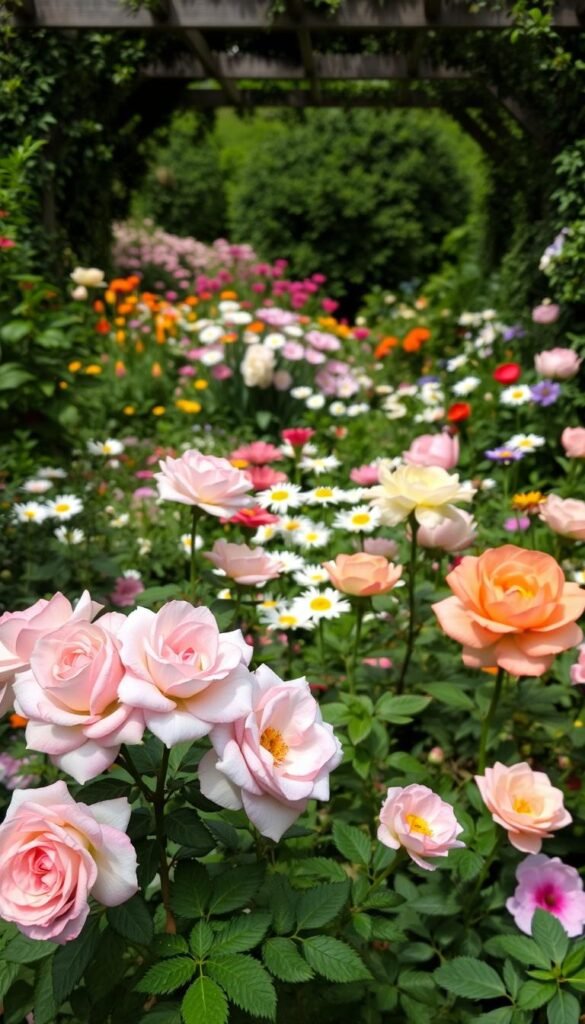
Think of your outdoor space as a painter’s canvas. Blending gentle tones with vibrant accents creates depth while keeping that cherished timeless feel. The magic happens when you balance proportions and let each shade enhance its neighbors.
Balancing Gentle Tones with Striking Accents
Start with soft pinks and creamy whites as your base. These hues act like a calming backdrop, letting bolder colors pop without competing. Try the 60-30-10 rule:
| Percentage | Tone | Purpose |
|---|---|---|
| 60% | Blush, lavender, ivory | Unify the space |
| 30% | Mauve, coral, peach | Add mid-layer interest |
| 10% | Burgundy, deep purple | Create focal points |
Morning light softens pastels, while afternoon sun intensifies richer shades. This natural rhythm keeps your design dynamic yet cohesive.
Creating Harmony with Complementary Colors
Pair opposites on the color wheel for instant drama. Crimson blooms beside silvery-green foliage make both tones shine brighter. Purple varieties gain depth when near lemon-yellow companions.
For subtle contrast, layer similar hues. Dusty pink next to mauve adds texture without jarring shifts. Remember: contrast doesn’t mean clash—it’s about guiding the eye through intentional pairings.
Harnessing Hybrid Tea and Climbing Roses for Structure
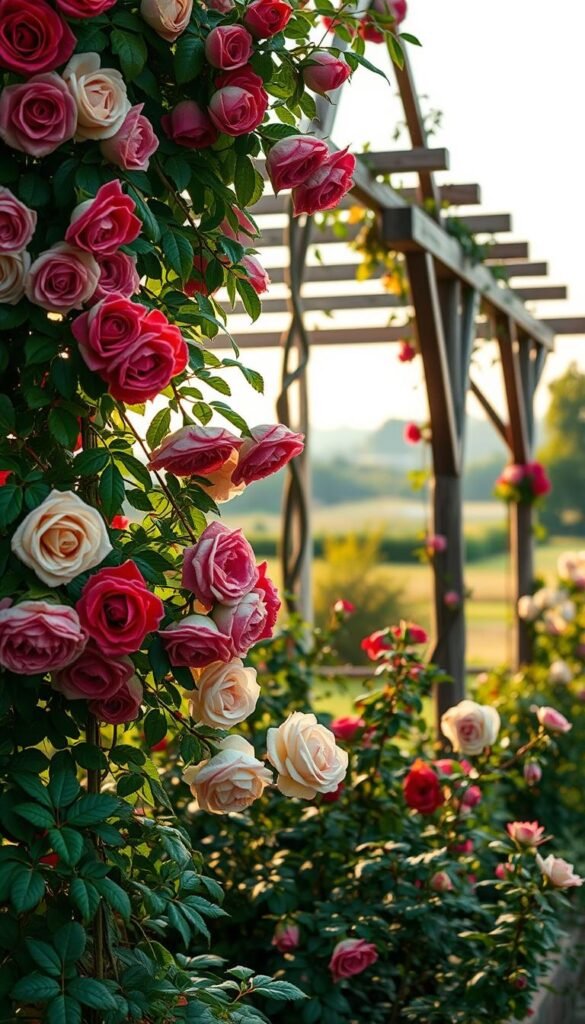
Visualize elegant pillars of color framing your outdoor sanctuary. Strategic placement of vertical and ground-level elements creates depth while guiding the eye through your space. Two star performers excel at this balancing act—one offering sculptural form, the other reaching skyward.
The Allure of Hybrid Tea Roses
Hybrid tea roses bring unmatched refinement with their high-centered buds housing 30-50 velvety petals. Their long, straight stems create natural exclamation points in borders or along pathways. These beauties grow up to 8 feet tall, making them perfect for creating structured focal points that command attention.
What truly sets them apart? Their talent for reblooming. You’ll enjoy waves of color from spring’s first warmth until autumn’s crisp days. Plus, their stems stay picture-perfect in vases—bring that elegance indoors with fresh-cut arrangements.
Enhancing Vertical Beauty with Climbing Varieties
While not true vines, climbing roses transform blank walls into living tapestries. Their stiff canes adapt beautifully to trellises or arched walkways. Here’s a pro tip: train them horizontally along fences for maximum flower production. This technique tricks the plant into sprouting more flowering side shoots.
Pair these vertical showstoppers with hybrid teas below. The combination creates layered interest—your eyes dance from earth to sky. Together, they form a three-dimensional masterpiece that makes every square foot count.
Designing Vertical Walls and Serene Pathways
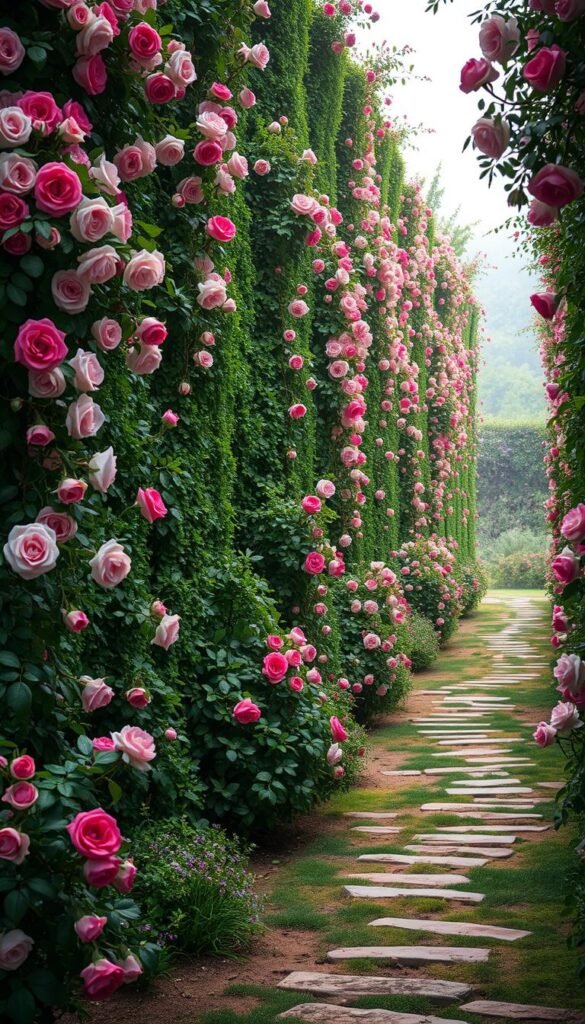
Turn unused vertical spaces into blooming masterpieces while crafting walkways that invite peaceful exploration. Clever design choices let you enjoy lush displays even in compact areas, blending practicality with natural charm.
Innovative Vertical Rose Garden Walls
Transform blank walls into living art with climbing varieties. Trellises offer classic support, while repurposed pallets add rustic character. Wall-mounted planters work wonders for patios, letting you layer colors vertically.
| Structure | Materials | Best For |
|---|---|---|
| Trellis | Cedar, metal | Formal designs |
| Planter wall | Resin, ceramic | Urban spaces |
| Repurposed pallet | Recycled wood | Budget-friendly projects |
These solutions save ground space while adding three-dimensional beauty. Train climbers horizontally along fences—this trick boosts flower production by up to 40%.
Crafting Meandering Walkways Lined with Blooms
Curved paths lined with fragrant bushes create moments of surprise. Alternate tall standards with low-growing varieties to frame the route. Choose repeat-blooming types so petals greet you all season.
Consider these pairings for sensory delight:
- Soft pink blooms beside silver-leafed plants
- Crimson flowers contrasting with ivory pebbles
- Groundcover varieties spilling over edges
The gentle crunch of gravel underfoot and sweet floral scents turn a simple stroll into a relaxation ritual. This approach nurtures that cherished sense of discovery, making every walk feel like unwrapping a gift.
Curating a Harmonious Color Palette for Your Garden
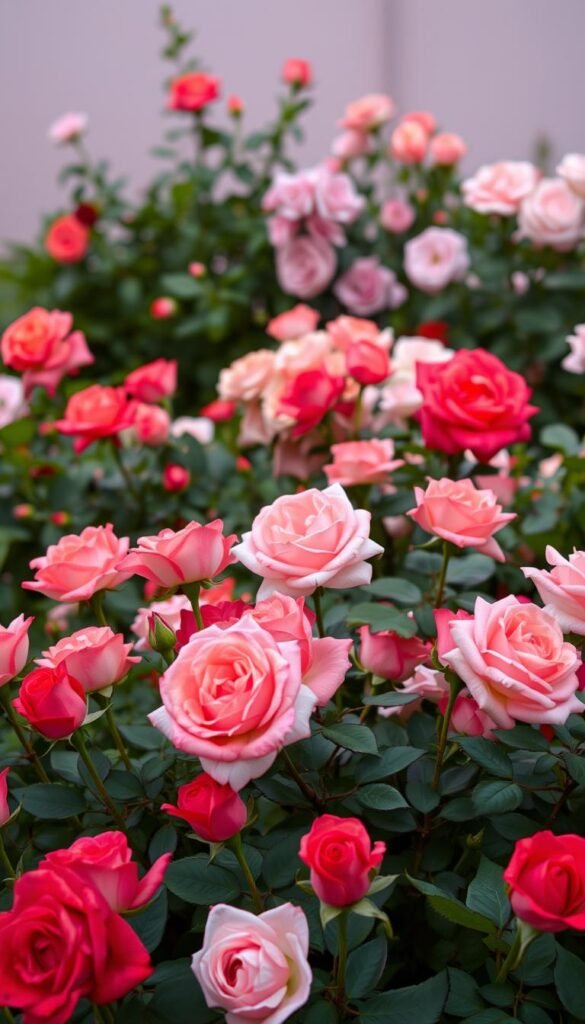
Color shapes emotion in your outdoor space, guiding how visitors feel as they explore. A well-planned scheme acts like visual poetry, blending tones that whisper or sing depending on their placement. Let’s explore how to craft combinations that resonate with your desired mood.
Tips for Crafting the Perfect Rose Palette
Start by choosing a base of soft pastels—think creamy whites or blush pinks. These gentle hues create unity across your space. Add depth with mid-tones like coral or mauve, then punctuate with deep reds or violet for drama.
Time your blooms strategically. Early-season varieties in lemon yellow transition to summer’s ruby tones, followed by autumn’s burnt oranges. This approach keeps your colors lively for months, not weeks.
Exploring Favorites Like Blushing Blooms and Lavender Dream
The ‘Blushing Blooms’ palette layers shades from ballet-slipper pink to velvety crimson. This gradient builds warmth, perfect for intimate seating areas. Pair with silver-leafed plants to make the pinks pop against cool foliage.
‘Lavender Dream’ offers tranquility through lilac and amethyst tones. Place these near pathways where their scent lingers in evening air. Morning light softens their purple shades, while dusk deepens them into twilight mysteries.
Remember: making perfect combinations means observing how sunlight alters tones hourly. Test placements by photographing spots at different times—you’ll discover surprises that refine your vision.
Rose Garden Aesthetic: Selecting Varieties and Colors for a Classic Look
Transform your outdoor space into a living tapestry where hues and textures tell a story. The secret to timeless appeal lies in pairing the right varieties with intentional color play. Whether you lean toward whisper-soft pastels or jewel-toned drama, every choice builds toward a cohesive vision.
Single-color groupings create instant focal points, guiding eyes through your garden like natural signposts. Try layering shades of crimson from velvety deeps to blushing lights—this monochromatic approach adds sophistication without overwhelming. For contrast, tuck clusters of pale yellows beside rich purples to make both tones sing.
Remember: great design thrives in balance. Let formal structure frame nature’s wilder beauty, like neat hedges cradling free-flowering climbers. Mix modern hybrids with heritage roses to enjoy both repeat blooms and nostalgic charm.
Your canvas awaits. With thoughtful selection, you’ll craft a space that feels both curated and effortlessly alive—a retreat where every season brings fresh magic to admire.

